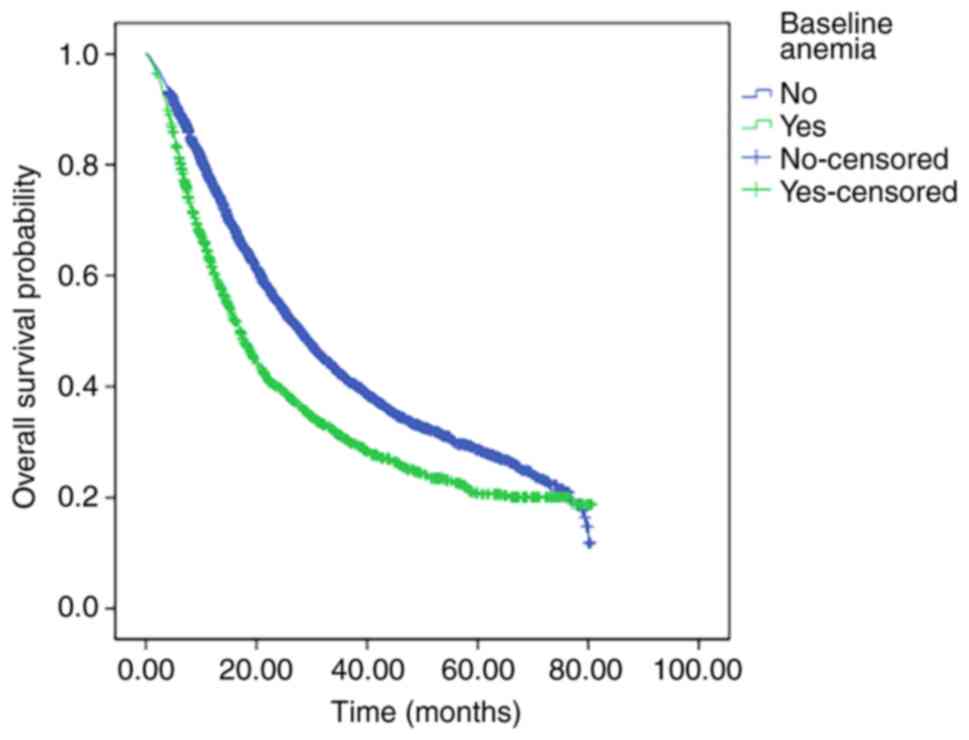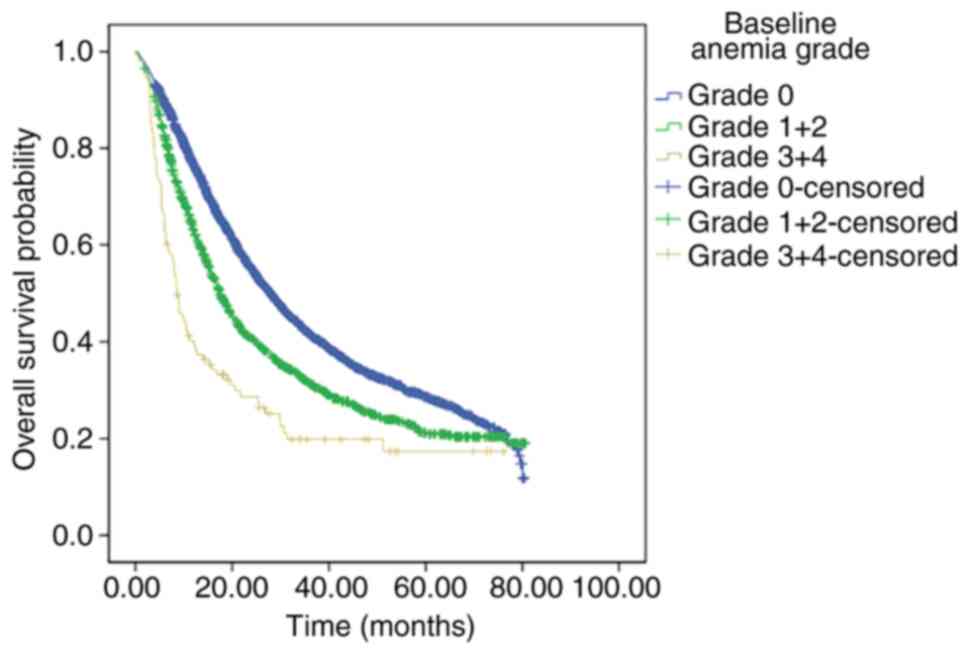|
1
|
Chen W, Sun K, Zheng R, Zeng H, Zhang S,
Xia C, Yang Z, Li H, Zou X and He J: Cancer incidence and mortality
in China, 2014. Chin J Cancer Res. 30:1–12. 2018.PubMed/NCBI View Article : Google Scholar
|
|
2
|
Gilreath JA, Stenehjem DD and Rodgers GM:
Diagnosis and treatment of cancer-related anemia. Am J Hematol.
89:203–212. 2014.PubMed/NCBI View Article : Google Scholar
|
|
3
|
Ludwig H, Van Belle S, Barrett-Lee P,
Birgegård G, Bokemeyer C, Gascón P, Kosmidis P, Krzakowski M,
Nortier J, Olmi P, et al: The European Cancer Anaemia Survey
(ECAS): A large, multinational, prospective survey defining the
prevalence, incidence, and treatment of anaemia in cancer patients.
Eur J Cancer. 40:2293–2306. 2004.PubMed/NCBI View Article : Google Scholar
|
|
4
|
Crawford J, Kosmidis PA, Hirsch FR and
Langer CJ: Targeting anemia in patients with lung cancer. J Thorac
Oncol. 1:716–725. 2006.PubMed/NCBI
|
|
5
|
Gascón P, Almenárez J, Artal Á, Camps C,
Fírvida JL, Garrido P, González Larriba JL and Montalar J:
Management of lung cancer-associated anaemia: The spanish lung
cancer anaemia survey (SLCAS). Clin Transl Oncol. 13:328–334.
2011.PubMed/NCBI View Article : Google Scholar
|
|
6
|
Wu Y, Aravind S, Ranganathan G, Martin A
and Nalysnyk L: Anemia and thrombocytopenia in patients undergoing
chemotherapy for solid tumors: A descriptive study of a large
outpatient oncology practice database, 2000-2007. Clin Ther.
31:2416–2432. 2009.PubMed/NCBI View Article : Google Scholar
|
|
7
|
Muñoz-Langa J, De Castro J, Gascó P,
Sanchez A, Esteban E, Gasent JM, Barneto I, Montalar J, Artal A and
Vidal S: Chemotherapy-associated anemia in patients with lung
cancer: An epidemiological, retrospective and multicenter study.
Future Oncol. 11:1665–1674. 2015.PubMed/NCBI View Article : Google Scholar
|
|
8
|
Cella D, Kallich J, McDermott A and Xu X:
The longitudinal relationship of hemoglobin, fatigue and quality of
life in anemic cancer patients: Results from five randomized
clinical trials. Ann Oncol. 15:979–986. 2004.PubMed/NCBI View Article : Google Scholar
|
|
9
|
Liu Y, Bai YP, Zhou ZF, Jiang CR, Xu Z and
Fan XX: Preoperative anemia as a prognostic factor in patients with
lung cancer: A systematic review and meta-analysis of
epidemiological studies. J Cancer. 10:2047–2056. 2019.PubMed/NCBI View Article : Google Scholar
|
|
10
|
Zhang YH, Lu Y, Lu H, Zhang MW, Zhou YM,
Li XL, Lv P and Zhao XY: Pre-treatment hemoglobin levels are an
independent prognostic factor in patients with non-small cell lung
cancer. Mol Clin Oncol. 9:44–49. 2018.PubMed/NCBI View Article : Google Scholar
|
|
11
|
Mandrekar SJ, Schild SE, Hillman SL, Allen
KL, Marks RS, Mailliard JA, Krook JE, Maksymiuk AW, Chansky K,
Kelly K, et al: A prognostic model for advanced stage nonsmall cell
lung cancer. Pooled analysis of North Central Cancer Treatment
Group trials. Cancer. 107:781–792. 2006.PubMed/NCBI View Article : Google Scholar
|
|
12
|
Wan S, Lai Y, Myers RE, Li B, Palazzo JP,
Burkart AL, Chen G, Xing J and Yang H: Post-diagnosis hemoglobin
change associates with overall survival of multiple
malignancies-results from a 14-year hospital-based cohort of lung,
breast, colorectal, and liver cancers. BMC Cancer.
13(340)2013.PubMed/NCBI View Article : Google Scholar
|
|
13
|
Aoe K, Hiraki A, Maeda T, Katayama H,
Fujiwara K, Tabata M, Kiura K, Ueoka H and Tanimoto M: Serum
hemoglobin level determined at the first presentation is a poor
prognostic indicator in patients with lung cancer. Intern Med.
44:800–804. 2005.PubMed/NCBI View Article : Google Scholar
|
|
14
|
Gauthier I, Ding K, Winton T, Shepherd FA,
Livingston R, Johnson DH, Rigas JR, Whitehead M, Graham B and
Seymour L: Impact of hemoglobin levels on outcomes of adjuvant
chemotherapy in resected non-small cell lung cancer: The JBR.10
trial experience. Lung Cancer. 55:357–363. 2007.PubMed/NCBI View Article : Google Scholar
|
|
15
|
Trufelli DC, Moraes TV, Lima AA and Giglio
AD: Epidemiological profile and prognostic factors in patients with
lung cancer. Rev Assoc Med Bras (1992). 62:428–433. 2016.PubMed/NCBI View Article : Google Scholar
|
|
16
|
Kay FU, Kandathil A, Batra K, Saboo SS,
Abbara S and Rajiah P: Revisions to the Tumor, Node, Metastasis
staging of lung cancer (8th edition): Rationale, radiologic
findings and clinical implications. World J Radiol. 9:269–279.
2017.PubMed/NCBI View Article : Google Scholar
|
|
17
|
Experts Committee on Cancer-Related Anemia
and Chinese Society of Clinical Oncology (CSCO). Clinical practice
guidelines on cancer-related anemia (2012-2013 Edition). Chin Clin
Oncol. 1(18)2012.PubMed/NCBI View Article : Google Scholar
|
|
18
|
Pathak RS, Pantarotto JR, Cook G, Holmes
O, Cross P and MacRae RM: Anemia is a poor prognostic factor for
stage I non-small cell lung cancer (NSCLC) patients treated with
Stereotactic Body Radiation Therapy (SBRT). Clin Transl Radiat
Oncol. 16:28–33. 2019.PubMed/NCBI View Article : Google Scholar
|
|
19
|
Topkan E, Selek U, Ozdemir Y, Yildirim BA,
Guler OC, Mertsoylu H and Hahn SM: Chemoradiotherapy-induced
hemoglobin nadir values and survival in patients with stage III
non-small cell lung cancer. Lung Cancer. 121:30–36. 2018.PubMed/NCBI View Article : Google Scholar
|
|
20
|
Passiglia F, Pilotto S, Facchinetti F,
Bertolaccini L, Del Re M, Ferrara R, Franchina T, Malapelle U,
Menis J, Passaro A, et al: Treatment of advanced non-small-cell
lung cancer: The 2019 AIOM (Italian Association of Medical
Oncology) clinical practice guidelines. Crit Rev Oncol Hematol.
146(102858)2020.PubMed/NCBI View Article : Google Scholar
|
|
21
|
Gascón P, Nagarkar R, Šmakal M, Syrigos
KN, Barrios CH, Sánchez JC, Zhang L, Henry DH, Gordon D, Hirsh V,
et al: A randomized, double-blind, placebo-controlled, phase ΙΙΙ
noninferiority study of the long-term safety and efficacy of
darbepoetinalfa for chemotherapy-induced anemia in patients with
advanced NSCLC. J Thorac Oncol. 15:190–202. 2020.PubMed/NCBI View Article : Google Scholar
|
















